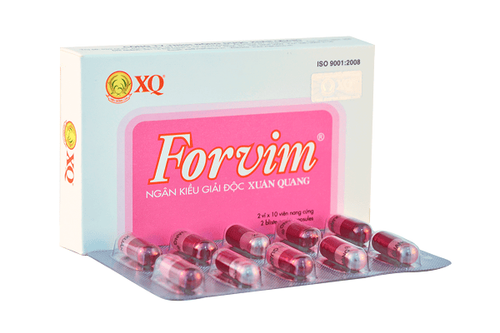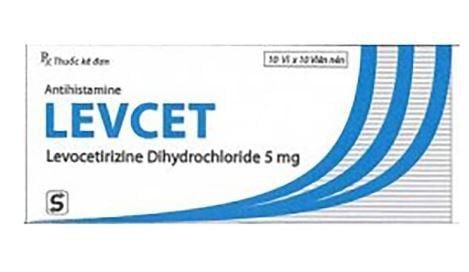This is an automatically translated article.
Food allergies are a number of problems that affect many people in the community, and sometimes require medical help. In fact, they affect about 5% of adults and 8% of children - and the number is growing. Although any food can cause an allergic reaction, statistics will show that some foods are more allergenic than others.1. What is a food allergy?
A food allergy is a condition in which certain foods trigger an abnormal immune response when entering the body. This is because the immune system misrepresents certain proteins in food as harmful. It then initiates a series of protective measures, including the release of chemical mediators such as histamine and inflammatory substances. For people with food allergies, even exposure to very small amounts of food can cause an allergic reaction.Symptoms of a food allergy can occur at any time, from a few minutes after exposure to several hours later. Suspicious symptoms may include some of the following:
Swelling of the tongue, mouth or face Shortness of breath Low blood pressure Vomiting Diarrhea Itchy rash In more severe cases, a food allergy can cause anaphylaxis . At this point, symptoms tend to manifest very quickly, including an itchy rash, swelling of the lining of the throat or tongue, difficulty breathing, and low blood pressure. Anaphylaxis if not treated promptly can cause death.
Many people with food intolerances are often confused with food allergies. However, food intolerances are never related to immune system responses. This means that while they can seriously affect your quality of life, food intolerances are not life-threatening.
2. Types of food allergies
Food allergies can actually be divided into 2 main categories: allergies through IgE antibodies or allergies through non-IgE antibodies. An antibody is defined as a protein in the blood that is used by your immune system to recognize and fight infection. In IgE-mediated food allergies, IgE antibodies are released by your immune system. In the case of a non-IgE food allergy, IgE antibodies are not released but other parts of the immune system are used to fight the danger recognized through the immune system.Here are the foods that cause allergies.
2.1 Cow's Milk Allergy to cow's milk is most common in infants and young children, especially when they are exposed to cow's milk protein before they are 6 months old. It is one of the most common childhood allergies, affecting 2-3% of babies and toddlers. However, about 90% of children will clear the disease by the time they are 3 years old, which makes it less common in adults.
Cow's milk allergy via IgE and non-IgE antibodies. But IgE-mediated cow's milk allergy is both common and can cause the most serious complications. Children or adults with an IgE allergy tend to react within 5–30 minutes of drinking cow's milk. Common clinical manifestations include facial edema, skin rash, urticaria, vomiting, and may even lead to anaphylaxis. Non-IgE allergies are more commonly associated with intestinal symptoms such as vomiting, constipation, or diarrhea, as well as inflammation of the intestinal wall. Non-IgE milk allergy can be more difficult to diagnose. This is because sometimes symptoms can suggest an intolerance and there is no specific blood test to detect it.

Dị ứng với sữa bò thường gặp nhất ở trẻ sơ sinh và trẻ nhỏ, đặc biệt là khi chúng tiếp xúc với protein sữa bò trước khi chúng được 6 tháng tuổi
2.2 Eggs Eggs are the 2nd most common cause of food allergies in children. However, 68% of children with an egg allergy will develop an allergy by the time they are 16 years old. Symptoms include:
Gastrointestinal disturbances, such as abdominal pain Skin reactions, such as rash Respiratory problems Anaphylaxis (rare) Interestingly, a person can only experience allergies corresponds to egg whites but not yolks and vice versa. This is because the protein structure of egg yolk and egg white is not the same. Most of the allergenic proteins are found in egg whites, so egg white allergies are more common. Like other allergies, the treatment for an egg allergy is to follow an egg-free diet. However, you may not have to avoid all foods associated with eggs, as heating eggs can change the shape of allergenic proteins. This can prevent the body's immune system from viewing them as harmful, which means they are less likely to cause a reaction.
In fact, one study found that about 70% of children with an egg allergy can eat cookies or cakes with cooked egg ingredients. Some studies have also shown that introducing baked goods to children with egg allergies can shorten the time it takes for them to recover. However, this is not true for everyone and the consequences of ingesting eggs when you are allergic to them can be very serious. Therefore, you should consult your doctor before reintroducing any foods containing eggs.

Trứng là nguyên nhân gây dị ứng thực phẩm phổ biến thứ 2 ở trẻ em
People with tree nut allergies will often also be allergic to foods made with these nuts, such as nut butters and oils. They are advised to avoid all tree nuts, even if they are allergic to only 1 or 2. This is because being allergic to one tree nut increases your risk of being allergic to other tree nuts. Also, it's easier to avoid all nuts, rather than just 1 or 2.
Unlike some other allergies, tree nut allergies usually last a lifetime. Allergies can also be very serious, and tree nut allergies are responsible for about 50% of anaphylaxis deaths. Therefore, people with nut allergies (as well as other potentially life-threatening allergies) are advised to carry an anaphylactic injection pen with them at all times. The injector pen is a potentially life-saving device that allows allergy sufferers to inject themselves with an adrenaline shot should they begin to have a severe allergic reaction. Adrenaline is a naturally produced hormone that stimulates the body's "fight or flight" response to stress. When given to people with severe allergic reactions, it can reverse the effects of an allergic reaction and save lives.
In summary, tree nut allergy is one of the most common food allergies. It is often associated with severe allergic reactions and treatment is usually lifelong avoidance of all tree nuts and tree nut products.
2.4 Peanuts Like tree nut allergies, peanut allergies are very common and can cause serious allergic reactions, including death. However, the two conditions are considered distinct, since peanuts are a legume. However, people with peanut allergies are also often allergic to tree nuts. Although the reason why people develop peanut allergies is not known, it is thought that a family history of peanut allergy is the most obvious risk factor. Therefore, it was previously thought that the introduction of peanuts into the diet of nursing mothers or during weaning could induce peanut allergy. However, studies have shown that early introduction of peanuts is actually protective.

Đậu phộng rất phổ biến và có thể gây ra các phản ứng dị ứng nghiêm trọng, bao gồm cả tử vong
Peanut allergy is a serious condition that can cause a severe allergic reaction. Treatment is lifelong avoidance of peanuts and peanut-containing products.
2.5 Wheat A wheat allergy is an allergic condition caused by various proteins found in wheat. Children are most likely to have a wheat allergy. Like other allergies, a wheat allergy can lead to digestive upset, hives, vomiting, rash, swelling, and possibly life-threatening anaphylaxis.
People with a wheat allergy need only avoid wheat and can tolerate gluten from wheat-free grains. Wheat allergy is usually diagnosed through a skin prick test. The most effective treatment is to avoid the use of wheat and wheat-based foods. This means avoiding foods, as well as beauty products and cosmetics that contain wheat.
2.6 Soy Soybean allergy occurs in about 0.4% of children and is most common in infants and children younger than 3 years of age. The allergic reaction is triggered by a protein in soy or soy-containing products.
Symptoms may include itchy mouth and runny nose, rash and asthma or difficulty breathing. In rare cases, a soy allergy can also cause anaphylaxis. Some children allergic to soy are also allergic to cow's milk protein. Soy milk and soy sauce are two common foods that cause allergies. Because soy is an ingredient found in many different foods, it's important to read food ingredient labels. Like other allergies, the only treatment for a soy allergy is to avoid soy.
2.7 Fish Fish allergies are very common, affecting about 2% of adults. Unlike other allergies, fish allergies are not uncommon, with 40% of people developing allergies as adults. Fish allergy can also cause serious and potentially fatal allergic reactions. The main symptoms are vomiting and diarrhea, but in rare cases anaphylaxis can also occur. This means that people who are allergic to fish are often given an injection pen to carry in case they are caught eating fish.

Dị ứng cá rất phổ biến, ảnh hưởng đến khoảng 2% người lớn
In summary, a food allergy is a condition that can occur at any time, with anyone, in case of danger, needing to take the allergic person to the hospital for timely emergency treatment. Currently, Vinmec International General Hospital is one of the leading prestigious hospitals in the country, trusted by a large number of patients for medical examination and treatment. Not only the physical system, modern equipment: 6 ultrasound rooms, 4 DR X-ray rooms (1 full-axis machine, 1 light machine, 1 general machine and 1 mammography machine) , 2 DR portable X-ray machines, 2 multi-row CT scanner rooms (1 128 rows and 1 16 arrays), 2 Magnetic resonance imaging rooms (1 3 Tesla and 1 1.5 Tesla), 1 room for 2 levels of interventional angiography and 1 room to measure bone mineral density.... Vinmec is also the place to gather a team of experienced doctors and nurses who will greatly assist in diagnosis and timely Treatment helps prevent dangerous complications that can occur with allergic patients. In particular, with a space designed according to 5-star hotel standards, Vinmec ensures to bring the patient the most comfort, friendliness and peace of mind.
Please dial HOTLINE for more information or register for an appointment HERE. Download MyVinmec app to make appointments faster and to manage your bookings easily.
Reference sources: webmd.com, healthline.com












